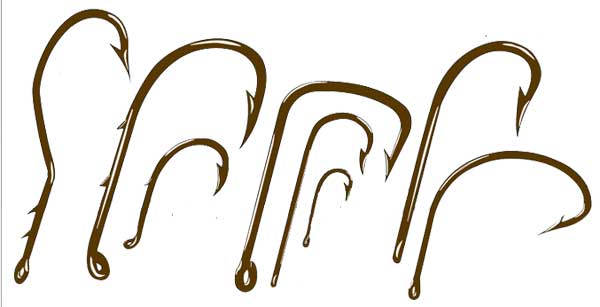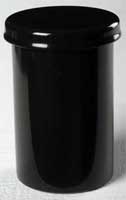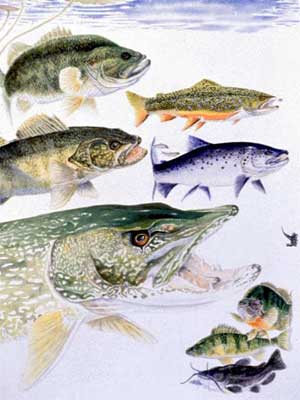Basic Fishing for Fun, Supplement and Survival
Fishing can be fun and a good way to help provide additional fresh sources of food for the family. From coast to coast, everyone lives near bodies of water, from the ocean, to landlocked bays, to ponds, rivers, lakes, streams etc. Contrary to fishing shows and sporting good stores, you can get a lot of mileage out of some very basic, versatile and inexpensive fishing gear. In this article, we will try to show the basic of tackle that are actually necessary to successfully catch most any type of fish.
Now, get to your local department store or where ever fishing tackle is sold. You need not spend a fortune to get everything you will need for basic fishing. As little as $20, if you are truly frugal, can provide you with years of tackle. Please bear in mind that fishing and supplies can be very specialized to the point of even being scientific in application and specialty. We are only going to cover bare bones fishing needs here, and general types of fish that are abundant everywhere.
Hooks
If at all possible, buy a cheap multi-pack of any brand of hooks as long as the pack contains sizes ranging from #2 to #14. This pack should cost no more than $5 to $10. Most multi-packs contain about 25 to 30 different hooks, in various sizes, and cover most every need for both the saltwater or freshwater fisherman. Barbed hooks are recommended.
 |
Line
Clear, cheap mono-filament ($2 a spool) in 4lb test, 8lb test, 12lb test, and 15 or 20lb test (heavier line for heavy fish, like saltwater, or freshwater stripers, and catfish). Four cheap spools will cover most fishing needs where ever you fish. For bobbers or bait flotation, salvaged wine corks work fine.
Sinkers
Sinkers are used to introduce bait to the bottom of a body of water, to hold a bait stable, or in a single area. Egg sinkers (shaped like an egg, with a hole in the middle) threaded through the line, with a swivel, and 24-inch leader line with a hook attached. Surf fishing may require triangular weights to act more as anchors. For lighter pond or lake fishing, split shot weights are the best. If you aren’t concerned with appearances, washers from your local hardware store will do the trick as well. They are cheaper and you get much more by the pound, and are simple to attach to line using either the hole in the washer or a snap clip or swivel. I have seen fellow angler’s use just about anything small and heavy, including used spark plugs!
 |
Small Fishing Kit
 A plastic 35 mm. film bottle with a snap-on cap makes a great mini-tackle kit that can be tucked away in pack, purse or car. They’re tough, reasonably watertight and can often be had for the asking at drug stores that process film.
A plastic 35 mm. film bottle with a snap-on cap makes a great mini-tackle kit that can be tucked away in pack, purse or car. They’re tough, reasonably watertight and can often be had for the asking at drug stores that process film.
In it I place an assortment of long-shank hooks (they seem to be most effective), about a dozen split-shot sinkers at least 30 feet of 20 pound test mono-filament line held in a small coil with a rubber band or a wire tie, a scented rubber worm, and a spinner for jigging. And even with all this, there is still room for swivels, a steel leader, extra hooks or a number of other small items. The film bottle itself will also work efficiently as a fishing float or “bobber”. As an alternative, making a bobber from a twig is simple.
The Fish
The all around lake, pond, or river source of fresh food is the Catfish. Channel Cat’s, Flathead’s, Yellow Cat’s, whatever you call them, they are abundant just about every where freshwater bodies exist. Catfish are easily caught in the spring and summer months. In the winter or colder months catfish can be found in the deeper holes at the bottom of a body of water. Catfish eat everything from worms, other chunks of cut fish, crawdads, small perch, pieces of hotdogs, and chunks of cheese or dough seasoned with garlic, or whatever. I do not believe I have seen a catfish turn down anything that resembles something than can be swallowed. The favorite baits are blood baits, cheeses, night crawlers, chicken livers, and various flavored dough baits. When fishing for catfish, use heavier line (12lb test or more), and at least a #2 to #4 hook, with at least a one ounce weight. A medium action rod is the lightest rod I would suggest. Finally, be careful in handling catfish as they have sharp spines on the two forward lower fins, and the single top fin. These fins in smaller catfish can produce painful wounds!
 Bass, Bluegill or Sun Perch, Crappie, Panfish
Bass, Bluegill or Sun Perch, Crappie, Panfish
The most common of freshwater sportfish is the Bass. Largemouth, or smallmouth, bass can be found in all inland waters that will support fish. Bass are readily caught in the summer months using just a hook, with a worm, or artificial baits. For perch, crappie, and panfish in general, a light tackle outfight is best, using a 4lb test line and a #10 or #12 hook. For panfish, small insects such as crickets, small red or mealworms, work well. The most successful fishermen fish areas where there is plenty of cover, like submerged bushes, or trees, or even underwater shelves, or submerged cover, obstacles, or “reefs”. Fish seek suitable “habitat” and cover, just as we do, and for the fisherman without a boat, this is important to remember.
Carp
Freshwater carp are abundant in most all lakes and rivers, and can grow very large. Most fisherman throw carp away, or back into the water, simply because for years carp has been considered a “junk fish” in American waters. Carp can easily be caught using a small treble hook, and garlic flavored “dough” type baits. Some people use corn (canned yellow corn). In the east, carp are the staple of the diet, and is delicious steamed, broiled, or boiled with spices and seasonings added. If preparing carp, keep in mind that carp have many bones, so carp is best steamed, until the bones become soft. Carp, like Catfish, can grow very large, so be prepared. I once caught a 15 pound carp.
Expedient Fishing
Fishing on a String and a Prayer
As a boy, we lived near a pond. I loved to visit this pond, and sit close to the water’s edge. I saw turtles, snakes, large fish chasing minnows, frogs, and all types of life thrived in that small pond. I recall I wanted to fish that pond so badly, but couldn’t convince my parents to buy me fishing pole or tackle. I would just have to use whatever I could find.
I knew I had to have some way to hold a fish once it bit, and a safety pin seemed to be just the thing! I picked out a shiny steel safety pin half the length of my thumb. Combined with a spool of string from the remains of my ill-fated kite. I had my new fishing tackle. I headed for the pond, excited with visions of monstrous fish in my mind. I gathered my bait in the form of any unfortunate insect I could find and catch from rotten logs and beneath stones.
I unwound about 15 feet of string, and cut and tied the end of it on a large stick so I could hold it, and I gently tossed baited hook into the water under the shade of some bushes. Not two seconds passed when the water exploded under the worm, and I watched in tremendous excitement as the caterpillar disappeared, and the side view of a huge (in the eyes of a ten year old) greenish scaly fish rolled over in the water. and dived under. I counted to five (to give the fish time to swallow the safety pin) and then a gave a sharp pull on the string. 5 minutes later I was holding a largemouth bass! (looking back now, I believe the fish was perhaps a pound to maybe a pound and a half). I caught two other bass that afternoon, with just kite string, and a safety pin.
Other Aquatic Food Sources

Most bodies of water also contain turtles, and crawdads. In shallow brackish streams and ponds, crawfish can be collected by the bucketful, by hand, in a short period of time.
One method of catching crawfish is to build a small wire mesh cage (2ft x 2ft x 1ft) or a box with a hinged, closeable lid, cutting a 2″ round hole in one side, near the bottom of the box or small cage. Next, tie a raw chicken leg, or wing, or dead perch, or chunk of fish on the inside, on the bottom in the center of the box, or cage, and submerge where ever crawfish are present, wait 30 min. to an hour, and pull the box or cage out of the water. Crawdads (crayfish) are best boiled in salted, or seasoned water. after cooking, just separate the tail from the body, peel the shell off the tail, and enjoy.
Other Methods
During spawning times, carp, and catfish can be found close to the waters edge in lakes and ponds. Some may be caught by hand, if you are quick and agile, otherwise, fish in shallow water can be speared with a simple long knife tied to a pole, or scooped up in hand held fishing nets (if you own one). If you find yourself in a populated area, and can do nothing else, hang out at shores edge by other anglers, and watch what they are doing, and watch how they are doing it. If you see someone throwing fish back because they are “junk fish” ask the angler for the fish, chances are, He/She will be happy to let you have them. If you are fortunate enough to live in isolated areas, or have access to such, remember that bodies of water draw an abundance of game, both in early morning, noon and early evening hours. Isolated ponds offer an excellent chance of bagging game to bring home to the dinner table as well as offering alternate food sources of the freshwater variety.
Tending Your Fishing Spot
Once you find a fishing spot you like or have reliable access to, you may want to consider building a cheap and easy Feeder System to greatly increase the yield and size of your fish.
Additional Research:
   |

Leave a Reply